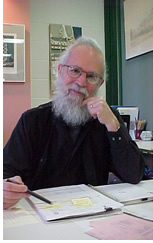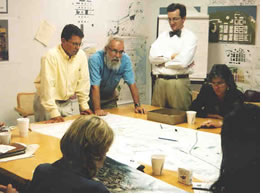
AIA Honors 2001 Thomas Jefferson Award winner Stroud Watson

"Roger & Me," the acclaimed movie documenting Flint, Michigan's, 1980s decline, points up the difficulty of mapping a new vision for a city based on something other than its traditional economic foundation. Among the costly missteps Flint's city fathers took to counteract the exodus of jobs and people after the closing of several of its auto plants, the film notes, were to reposition Flint as a tourist destination and construct a multi-million-dollar theme park, luxury hotel, and pavilion—all of which soon went bankrupt.
"Chattanooga was, in fact, a Flint, Michigan," says Stroud Watson, "in the sense that at the end of the war, Chattanooga was the seventh-largest heavy industrial town in the country." As in Flint, automotive interests scaled back their investment in the local economy—which in Chattanooga's case meant the closing of its foundries. Gone was the city's notorious smog problem, but along with it went much of its economic base and its downtown residents.
 Right
man; right place; right time
Right
man; right place; right time
Having spent much of the 1970s as architect and designer for the planned
city of Milton Keynes, north of London, Watson had returned at decade's
end to the U.S. determined to "bring the notion that we can design
and build communities that serve all of our citizens better." In
particular, Watson was interested in a position in which he could combine
teaching at a university with working in the community.
Amidst a two-year coast-to-coast lecture series, wherein Watson surveyed
the landscape for such a situation, he was introduced to Rick Montague,
then-president of the Chattanooga-based Lyndhurst Foundation, who expressed
his desire to create a city that its young people would want to return
to after completing their education. "I said I'd like to get involved,"
Watson recalls, "and we set up a grant with the foundation that is
still going on now 21 years later."
Armed with the ideas and enthusiasm of his UT Knoxville School of Architecture students, Watson, via his direction of the Urban Design Studio, took their emerging concepts to remake downtown Chattanooga to the citizenry. In a 20-week series of community meetings, Watson, his students, and their cohorts directed discussion of the full range of planning issues toward the formulation of a $750 million plan, dubbed "Vision 2000," to reclaim the city's riverfront and its downtown commercial and residential presence.
"My understanding of the best way to use public participation," Watson says of the experience, "is to raise the level of the playing field and then give the citizens the opportunity to understand what could be—and choose whether they want to get there."
Designing the right
'living room'
From the outset, two conditions were glaringly absent from Chattanooga's
downtown: there was no obvious city center, nor was there any "connection"
between downtown and the adjacent Tennessee River. On a deeper level,
Watson and his students also worked to shift Chattanoogans' view of their
city "from that of a series of objects in an undifferentiated field
to looking at what I call the 'living room' of the city-the streets, parks,
plaza, and those public buildings that make up the collective space that
is accessible to everybody."
To help establish a recognizable city core that would draw residents downtown, Watson, in conjunction with Koetter Kim & Associates, designed the Miller Park District-a master plan for a five-block mixed-use development including approximately 500,000 square feet of office space, 100,000 square feet of commercial space, and 150 housing units. A subset of the plan, Miller Plaza, a 26,000-square-foot public park with pavilion and performance stage-which opened in 1988 and won an AIA Honor Award for Architecture the following year-draws 55,000 people annually to its year-round free events.
Connecting the downtown to the river now is Ross's Landing Park and Plaza, a four-acre district containing historic and interpretive exhibits, a water wall, boat dock and launch, and dining areas, which serves as the setting for the $45 million Tennessee Aquarium. Watson served as design director for both projects, which drew over two million people in the year after they opened in 1992. Part of the larger Tennessee Riverpark-a master plan developed in conjunction with Carr Lynch Associates that will ultimately create a park and economic structure along 22 miles of riverfront in and around Chattanooga—the project reclaims the city's riverside birthplace, which fell into disuse and disintegrated after the city's industrial base eroded.
Money Talks
Perhaps as significant as the many awards, and the many people, that Watson's
projects have attracted is the public and, particularly, private investment
that they have drawn. Of 31 major projects undertaken in downtown Chattanooga
between 1988 and 1999, representing $443 million in investment, $369 million—almost
80 percent—of funding came from the private sector. Over two-thirds
of those projects, including the aquarium, an IMAX theater, a museum,
stadium, restaurants, hotels, and apartments, involved no public funds
whatsoever.
 The
Lyndhurst Foundation has been a central player in many of the projects
undertaken. But Watson has been the pivotal figure marshalling community
support for many of the projects while they were still in the planning
stages—which in synergistic fashion has commanded attention and funding
from the state and, in turn, from additional private investors. He has
also been the key coordinator ensuring the design teams adhere to the
original vision—avoiding the Flint experience.
The
Lyndhurst Foundation has been a central player in many of the projects
undertaken. But Watson has been the pivotal figure marshalling community
support for many of the projects while they were still in the planning
stages—which in synergistic fashion has commanded attention and funding
from the state and, in turn, from additional private investors. He has
also been the key coordinator ensuring the design teams adhere to the
original vision—avoiding the Flint experience.
The Tennessee Aquarium in Ross's Landing is a case in point. "It was a long struggle to sell it," says Watson, noting that objections were raised to putting money into "a fish tank" that could have been used for education or transportation. But the idea behind the aquarium, which Watson and his students eventually sold the community on, was to provide a catalyst to attract people on the regional level to the park and, ultimately, to the nearby downtown.
Eventually, the community fell solidly behind the idea, garnering the interest of the state, which earmarked $8 million for the project, as well as the city and private investors—a snowballing effect. Ultimately, private investors donated so much for the project that the public money was taken out and instead used to develop Ross's Landing Plaza. Within two years of the Plaza's opening, new private investment totaling over $100 million was committed to land parcels less than two blocks away.
Bringing people downtown
. . . to stay
The final piece of Chattanooga's development plan is to create a vibrant
downtown residential community. The 41-unit Riverset Apartment complex,
situated on Ross's Landing, represents the first new housing in downtown
Chattanooga in over 20 years. Outfitted with fireplaces, balconies with
river views, and opening on to the Riverwalk, the apartments, 20 percent
of which were set aside for low- and moderate-income residents, were completely
occupied within eight months of opening—at market-rate rents.
"That doesn't sound like much," Watson says of the complex's size. But, he notes, the project's success has given investors the confidence necessary to build additional residential housing in the city's South Central Business District.
"Confidence" is a word Watson uses frequently when describing the city's rising fortunes in the 20 years since he arrived. And he notes that it's unusual to develop the confidence to enact such big plans as Chattanooga's at a time when the city wasn't expanding rapidly. "We're not a boom town," Watson says.
Maybe not in the classic sense—connoting pollution, traffic, and sprawl—but, as measured by private investment, economic activity, and the return of tourists and residents alike to its downtown area, Chattanooga most assuredly is booming. And it can thank in large part the vision, energy, and confidence of Stroud Watson, who has proved that if you build it—and design it well—they really will come.
Copyright 2001 The American Institute of Architects. All rights reserved.
![]()
|
|
|